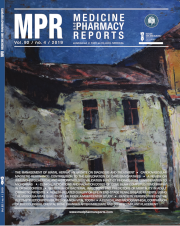Dentists’ perspectives on the reconstruction possibilities of a non-vital tooth
DOI:
https://doi.org/10.15386/mpr-1148Keywords:
non-vital teeth, reconstruction, fiber post, cast post-and-coreAbstract
Background and aims. The decision-making process when restoring a non-vital tooth is influenced by multiple factors. This study aimed to survey the dentists’ preferences regarding cast post-and-core and fiber post techniques for the reconstruction of non-vital teeth and to identify a correlation between reconstruction technique and practitioners characteristics, or dental characteristics.
Methods. The survey instrument was a questionnaire, which included a general part with questions regarding the practitioner’s profile (gender, age, years of experience, pattern and location of practice, etc.) and the dental characteristics (anterior or posterior position of the tooth on the arch, the amount of dental remaining tissues, etc.). and a technical part, containing more specific questions regarding the manufacture and performance of root-coronal reconstructions.
Results. Among the surveyed practitioners (n=35), 69.7% use more often cast post-and-core reconstructions (CPR) while 30.3% choose fiber post reconstructions (FPR). No difference in the reconstruction type was observed regarding patient’s age (p=0.23) or gender (p=0.092). The para-function criterion was considered important by 8.23% of the participants. When deciding the type of the root-coronal reconstruction depending on the remaining dentine walls, CPRs are significantly more frequently used in posterior areas (p=0.043) or when para-functional habits exist (p=0.022).
Conclusion. Cast post-and-core represent the most frequently used type of reconstruction for non-vital teeth. Fiber post reconstructions are indicated in the aesthetic zone and when the amount of healthy remaining dental structure is higher.
Downloads
Published
How to Cite
Issue
Section
License
The authors are required to transfer the copyright of the published paper to the journal. This is done by agreeing to sign the Copyright Assignment Form. Whenever the case, authors are also required to send permissions to reproduce material (such as illustrations) from the copyright holder.

The papers published in the journal are licensed under a Creative Commons Attribution-NonCommercial-NoDerivatives 4.0 International License.

